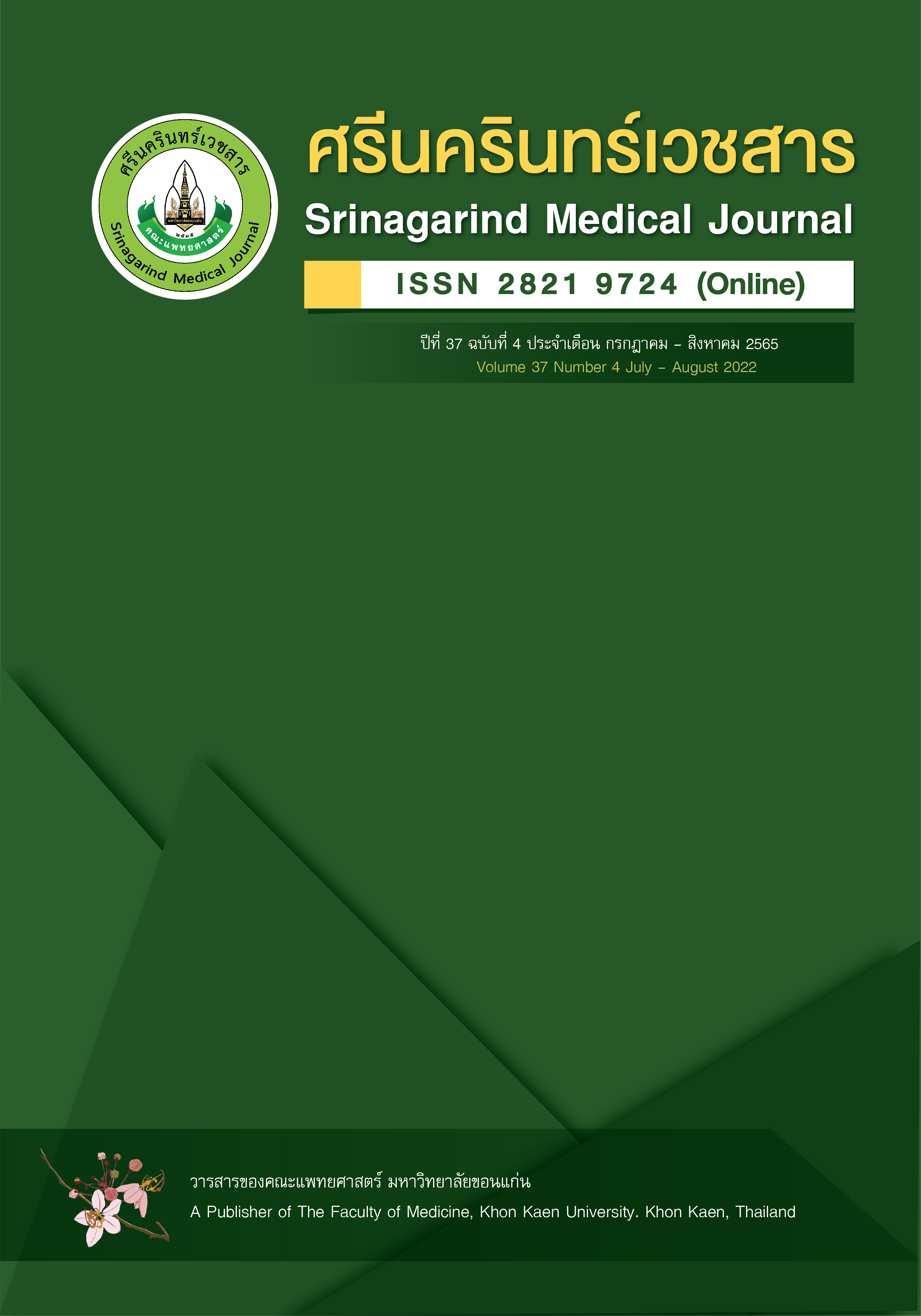ภาวะลิ่มเลือดอุดตันหลังการใช้ยาแอสพาราจิเนส ในผู้ป่วยเด็กมะเร็งเม็ดเลือดขาวลิมโฟบลาสต์และมะเร็งต่อมน้ำเหลือง
Abstract
Asparaginase with Thrombotic Complications in Pediatric Acute Lymphoblastic Leukemia and Lymphoblastic Lymphoma
Kunanya Suwannaying*, Patcharee Komvilaisak, Busara Charoenwat, Watuhatai Paibool , Napat Laoaroon
Department of Pediatrics, Faculty of Medicine, Khon Kaen University, Khon Kaen, Thailand 40002
หลักการและวัตถุประสงค์: ภาวะลิ่มเลือดอุดตันเป็นภาวะแทรกซ้อนรุนแรงที่พบได้ในผู้ป่วยเด็กมะเร็ง ยา แอสพาราจิเนสซึ่งเป็นยาสำคัญที่ใช้ในการรักษามะเร็งเม็ดเลือดขาวและมะเร็งต่อมน้ำเหลือง เพิ่มความเสี่ยงในการเกิดลิ่มเลือดอุดตันได้ การศึกษานี้มีวัตถุประสงค์เพื่อหาอุบัติการณ์ ปัจจัยเสี่ยง ที่ทำให้เกิดลิ่มเลือดอุดตัน รวมถึงผลการรักษาผู้ป่วยหลังการเกิดภาวะลิ่มเลือดอุดตันตามหลังการใช้ยาแอสพาราจิเนส
วิธีการศึกษา: เป็นการศึกษาย้อนหลังเชิงพรรณนาในผู้ป่วยเด็กมะเร็งเม็ดเลือดขาวลิมโฟบลาสต์และมะเร็งต่อมน้ำเหลืองในโรงพยาบาลศรีนครินทร์ที่มีอายุน้อยกว่า 18 ปี ณ วันที่ได้รับการวินิจฉัยโรคมะเร็ง ตั้งแต่เดือน มกราคม 2540 ถึง ธันวาคม 2550 และได้รับการวินิจฉัยภาวะลิ่มเลือด โดยเก็บและวิเคราะห์ข้อมูลทั่วไปของผู้ป่วย อาการของภาวะลิ่มเลือดอุดตัน ปริมาณยาแอสพาราจิเนสสะสม ยากลุ่มแอนทราไซคลินและสเตียรอยด์ที่ได้รับในระหว่างการรักษาด้วยยาแอสพาราจิเนส ภาพทางรังสีในการวินิจฉัยภาวะลิ่มเลือดอุดตัน วิธีการรักษา รวมไปถึงผลหลังการรักษาลิ่มเลือดอุดตัน
ผลการศึกษา: พบว่า ผู้ป่วยเด็กมะเร็งเม็ดเลือดขาวลิมโฟบลาสต์และมะเร็งต่อมน้ำเหลือง 831 ราย ที่ได้รับการรักษาด้วยยาแอสพาราจิเนส มีผู้ป่วย 16 ราย เกิดลิ่มเลือดอุดตัน ค่ามัธยฐานอายุของผู้ป่วย คือ 12 ปี ค่ามัธยฐานของระยะเวลาการเกิดลิ่มเลือดอุดตัน คือ 17 วันหลังจากได้รับยา (อยู่ในช่วงระหว่าง 1 ถึง 41 วัน) โดยพบลิ่มเลือดอุดตันในตำแหน่งหลอดเลือดดำ (ร้อยละ 62.5) มากกว่าหลอดเลือดแดง (ร้อยละ 37.5) โดยที่ 14 ราย (ร้อยละ 87.5) เกิดลิ่มเลือดในระบบประสาท อาการที่พบบ่อยที่สุด คือ อาการชัก ผู้ป่วยส่วนใหญ่ได้รับยา แอสพาราจิเนสควบคู่กับการให้ยากลุ่มแอนทราไซคลินและสเตียรอยด์ ปัจจัยเสี่ยงที่ตรวจพบความสัมพันธ์ในการเกิดลิ่มเลือดอุดตันที่พบบ่อยที่สุด คือ ภาวะพร่องโปรตีน S รองลงมา คือ ภาวะขาด antithrombin และ โปรตีน C ผู้ป่วยส่วนใหญ่ได้รับการรักษาด้วยยากลุ่มเฮพารินที่มีน้ำหนักโมเลกุลต่ำ (ร้อยละ 81.1) ผู้ป่วย 8 ราย ภาวะลิ่มเลือดอุดตันสลายหมดหลังการรักษา ผู้ป่วย 4 รายพบลิ่มเลือดอุดตันบางส่วน ผู้ป่วย 2 ราย มีอาการดีขึ้น โดยไม่ได้ติดตามด้วยภาพถ่ายรังสี ผู้ป่วย 10 ราย (จาก 14 ราย) ที่มีลิ่มเลือดอุดตันในระบบประสาท มีผลการรักษาที่ดีมาก (ค่าคะแนน modified Rankin scale 0 หรือ 1) ในจำนวนนี้ ผู้ป่วย 12 รายรอดชีวิต ผู้ป่วย 2 ราย เสียชีวิตจากโรคมะเร็งลุกลาม และภาวะสมองขาดเลือด
สรุป: การรักษาโดยใช้ยาแอสพาราจิเนส ในผู้ป่วยเด็กมะเร็งเม็ดเลือดขาวลิมโฟบลาสต์และมะเร็งต่อมน้ำเหลืองควรมีการเฝ้าระวังภาวะลิ่มเลือดอุดตัน โดยเฉพาะในผู้ป่วยที่อายุ 10 ปีขึ้นไป ปัจจัยเสี่ยงที่พบมากที่สุด คือ ภาวะขาดโปรตีน S ผู้ป่วยที่ได้รับการรักษาโรคลิ่มเลือดอุดตัน มีผลการรักษาที่น่าพึงพอใจ การกลับมาใช้ยาแอสพาราจิเนสอีกครั้งค่อนข้างปลอดภัย อย่างไรก็ตาม เรื่องของปัจจัยเสี่ยงของลิ่มเลือดอุดตันตามหลังการใช้ยาแอสพาราจิเนส และแนวทางในการป้องกันลิ่มเลือดอุดตันหลังจากการใช้ยานี้ ยังต้องการการศึกษาเพิ่มเติมในอนาคต
Background and Objective: Thromboembolic events (TEEs) are serious complications of childhood cancers. Asparaginase is a standard chemotherapy agent which is successful against childhood acute lymphoblastic leukemia (ALL) and lymphoblastic lymphoma (LL). However, asparaginase increases the risk of TEEs. This retrospective descriptive study aims to describe the characteristics, treatment, and outcomes of children with asparaginase-related thrombosis in Srinagarind Hospital, Thailand.
Methods: Pediatric ALL and LL patients, aged under 18 years old at diagnosis of ALL and LL with definitely diagnosed TEEs, treated between 1997 and 2017, were retrospectively reviewed. Patient demographic data, clinical presentations of TEE, actual dosage of asparaginase, concomitant anthracycline and steroids administration, imaging study results, treatments, and outcomes, were all collected and analyzed.
Results: Of 831 ALL and LL patients, sixteen developed asparaginase-related TEE. Median age of patients with TEE were 12 years (range 3-15 years). The most common site of thrombosis was CNS thrombosis (14 patients). Venous sites were more common than arterial sites (62.5% versus 37.5%). Seizures were the most common presentation, with a median time of onset of 17 days from the first exposure (range 1–41 days). The majority of patients received anthracycline and steroids during asparaginase administration. Acquired protein S deficiency was the most common prothrombotic state, followed by acquired antithrombin and acquired protein C deficiency. Most patients were treated with low-molecular weight heparin (81.1%). Eight patients had complete responses, and four had partial responses, as assessed by imaging studies. Two patients had clinical improvement. Ten of 14 patients (71.4%) with CNS TEE had favorable outcomes (modified Rankin scale 0-1). Twelve patients (75%) were alive, two died from advanced cancer, and one died from brain herniation after cerebral infarction.
Conclusions: Caution is necessary concerning asparaginase-related TEE in leukemia and lymphoma patients, particularly in patients aged more than 10 years old. Protein S deficiency was the most common abnormal thrombophilic laboratory investigation. Post-TEEs treatment had favorable outcomes. Rechallenge of asparaginase is rather safe. Further larger prospective studies focusing on risk factors and TEEs prophylaxis studies should be conducted to improve outcomes.


